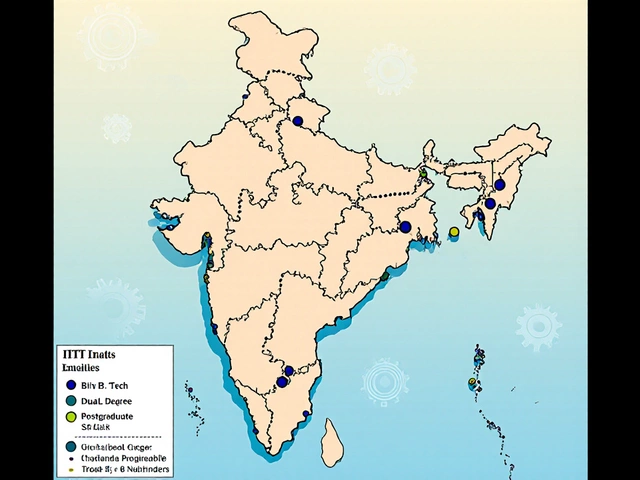Imagine scoring 99 percentile in JEE Main and still not getting your dream branch at an NIT. Sounds frustrating, right? That’s actually what happens every year. With more than a million students taking a shot at the NIT seats, a perfect percentile alone won’t always cut it, especially if you’re gunning for the big ones like NIT Trichy or Warangal. It's a game of numbers, rank, quota, seat matrix, category, and sometimes a bit of luck in the choice-filling rounds. So, what’s the real percentile you should be aiming for? Is 95 safe for NITs? What about reserved categories? Or state quotas? Let’s dig deep and solve this for good.
How Does JEE Main Percentile Work For NIT Admissions?
First off, the JEE Main score isn’t just a math test result. It uses a “percentile” system, not raw score, so your performance is measured by how many people you’ve beaten out—not just how many marks you get. If you get 98 percentile, that means you've done better than 98% of test-takers. In 2025, about 12.5 lakh students registered for JEE Main. That automatically puts percentile into perspective—it's your rank among a pretty huge crowd.
Why percentile and not marks? Because every session’s questions can be a bit harder or easier, so NTA, the organizer, “normalizes” scores. Whether you sit in January or April, morning or evening slot—doesn’t matter. Your percentile reflects where you stand compared to everyone who wrote the exam.
Your JEE Main percentile is the chief factor for admission to NITs. But it isn’t the only one. The actual call to the admission party is your “All India Rank” (AIR), which is calculated based on your best percentile across all attempts. Then, factors like home state quota, category reservation, and counseling round influence your shot at a seat. So, don’t just fixate on the percentile. It's the combination of percentile, rank, and seat matrix that controls the outcome.
Here’s a quick comparison from last year's JOSAA counseling about what different percentiles roughly translate to in terms of AIR:
| Percentile Range | Approx. JEE Main AIR |
|---|---|
| 99.9+ | Top 1,200 |
| 99.5 to 99.9 | 1,200 – 6,000 |
| 99.0 to 99.5 | 6,000 – 15,000 |
| 98.5 to 99.0 | 15,000 – 23,000 |
| 97.0 to 98.5 | 23,000 – 37,000 |
| 95.0 to 97.0 | 37,000 – 50,000 |
That gives you a tangible feel for the numbers behind the NIT cutoff race.
NIT Cutoff Percentile: What’s Actually Required?
The big question: what percentile seals your NIT seat? The short answer is "it depends”—mostly on the NIT, your category, quota (home state or other state), and branch. For top NITs like Trichy, Surathkal, or Warangal and the most wanted branches (CSE, ECE), the cutoff for general (OPEN) category can hover above 98.5 percentile—sometimes even closer to 99.3. But for NITs with lower opening ranks or less popular branches, you might sneak in with 95-96 percentile.
Diving into actual numbers from JOSAA 2024 closing ranks, here’s a more concrete scenario for General (OPEN- gender-neutral quota):
- NIT Trichy (CSE): Cutoff closing rank was around 9000, translating to about 99.2 percentile.
- NIT Surathkal (Mechanical): Closing rank hovered near 23,000, which fits around 98 percentile.
- NIT Nagaland (Civil): Closing rank stretched to 50,000, roughly equal to a 95+ percentile.
So, the range for your percentile depends on your target NIT and branch. If you belong to EWS, OBC, SC, or ST categories, the bar is lower, sometimes by as much as 10,000 ranks or about 2-3 percentile lower. For example, SC candidates can get into decent branches at mid-tier NITs even at 82-85 percentile. ST cutoffs can drop even lower in certain North-East NITs due to seat availability.
And don’t forget the Home State quota—it’s a game-changer. If you’re from Tripura, you have a much higher chance at NIT Agartala than someone from Maharashtra. Sometimes, a 94 percentile can fetch a decent branch if you have home state advantage and belong to a reserved category.
The “other state” quota is usually tougher since the pool is larger. Always cross-check last year’s closing ranks for your chosen NIT and category. The cutoffs dance a little every year—so treat last year’s numbers as guidelines, not gospel.

What Factors Influence the NIT Percentile Cutoff?
Think getting a high percentile is the end of the story? There’s more. Here are some real factors that move the needle on NIT admission odds:
- State Quota vs. Other State: Each NIT reserves 50% for home state candidates. In states with fewer JEE Main toppers, the closing percentile dips for the home crowd.
- Seat Matrix and Branch Popularity: CSE, IT, and ECE are always hotter and close at much higher percentiles. Civil or Biotechnology usually go at lower percentiles, especially by the last round.
- Category Reservation: General, EWS, OBC-NCL, SC, ST, and PwD all have separate cutoffs. That means a distinct percentile bar for every group. For OBC-NCL, EWS, and SC/ST, the advantage can be up to 15,000 ranks or more.
- Round of Counseling: JOSAA counseling has six rounds. The cutoff drops with each round as students withdraw or slide up. If you’re flexible about branches and ready to wait till the last round, your chances improve.
- Domicile Rules: For North-Eastern NITs, lesser number of applicants from home states means a comparatively lower cutoff within those states.
- Special / Female-Only Quotas: NITs have seats exclusively for females in many branches, giving a lower cutoff for girl candidates. In some cases, this difference can be up to 2 percentiles.
- No. of applicants and seat inflation: In 2024, over 12 lakh students appeared, but the number of seats went up only slightly. If more people score high marks, cutoffs go higher.
On top of all that, some seats are left open for foreign nationals, DASA, or CIWG students, which slightly reduces the available pool for Indian applicants.
Tips to Secure Your NIT Seat: Be Strategic About Percentile
If you’re really gunning for an NIT—it’s not just about scoring high. It’s about playing smart. Here are tips based on what toppers and counseling experts suggest:
- Be Realistic but Ambitious: Check last year’s closing ranks for your dream NIT/branch/category using the JOSAA Opening-Closing Rank tool. Set a percentile target that fits, but always give extra margin for yearly fluctuation.
- Maximize Attempts: JEE Main happens in two sessions. Attempt both. NTA will calculate your best percentile. This can mean the world if you have an “off day” in your first try.
- Target the Strongest Branch-Quota Combo: Are you eligible for Home State? Leverage it, especially in less crowded NITs. For girls, choose gender-neutral as well as female-only seats in your preference list.
- Category Documents Ready: Get your OBC-NCL/EWS/SC/ST certificates updated to the required date. A missing or outdated certificate can block admission even if you clear the cutoff.
- Consider Flexibility in Branch: In the last round, even lesser-known streams offer the "NIT" brand value you might want for future jobs or PG entrance. Many NITs allow internal branch change after the first year if you perform well.
- Fill Maximum Choices During JOSAA: Don’t play it safe with just a handful of branches and NITs. Fill the maximum number of relevant choices. This prevents seat loss due to too short a list.
- Monitor Opening and Closing Ranks After Each Round: Keep an eye on the JOSAA website during counseling week. If there’s a slide in ranks, you might get a better branch if you float/slide your seat in the next round.
The real trick is to stay motivated and not get disheartened by the "topper" stories online. Plenty of NIT alumni made it big from less-hyped branches or lower-cutoff NITs. The brand works, whichever branch or campus you end up in.
Just remember—the NIT percentile is the gateway, but the journey is all about strategy.







0 Comments